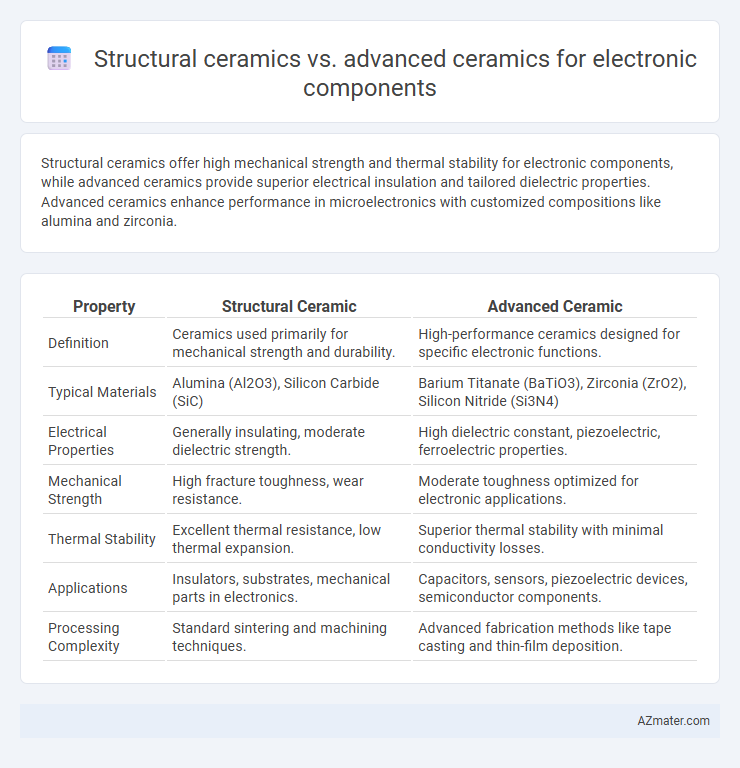Structural ceramics offer high mechanical strength and thermal stability for electronic components, while advanced ceramics provide superior electrical insulation and tailored dielectric properties. Advanced ceramics enhance performance in microelectronics with customized compositions like alumina and zirconia.
Table of Comparison
| Property | Structural Ceramic | Advanced Ceramic |
|---|---|---|
| Definition | Ceramics used primarily for mechanical strength and durability. | High-performance ceramics designed for specific electronic functions. |
| Typical Materials | Alumina (Al2O3), Silicon Carbide (SiC) | Barium Titanate (BaTiO3), Zirconia (ZrO2), Silicon Nitride (Si3N4) |
| Electrical Properties | Generally insulating, moderate dielectric strength. | High dielectric constant, piezoelectric, ferroelectric properties. |
| Mechanical Strength | High fracture toughness, wear resistance. | Moderate toughness optimized for electronic applications. |
| Thermal Stability | Excellent thermal resistance, low thermal expansion. | Superior thermal stability with minimal conductivity losses. |
| Applications | Insulators, substrates, mechanical parts in electronics. | Capacitors, sensors, piezoelectric devices, semiconductor components. |
| Processing Complexity | Standard sintering and machining techniques. | Advanced fabrication methods like tape casting and thin-film deposition. |
Introduction to Ceramics in Electronics
Structural ceramics in electronic components primarily offer mechanical strength and thermal stability, making them ideal for substrates and insulating parts. Advanced ceramics incorporate enhanced electrical, magnetic, or thermal properties tailored for high-performance functions such as sensors, capacitors, and semiconductors. The integration of these materials in electronics improves device durability, miniaturization, and operational efficiency by leveraging their unique physical and chemical characteristics.
Defining Structural Ceramics
Structural ceramics are inorganic, non-metallic materials known for their high mechanical strength, hardness, and thermal resistance, primarily used in components that require durability and wear resistance. Advanced ceramics, often including structural ceramics, emphasize enhanced electrical, thermal, and chemical properties tailored for electronic components such as sensors, insulators, and substrates. Defining structural ceramics involves highlighting their role in providing mechanical integrity and stability, distinguishing them from other ceramics designed primarily for specific electrical or thermal functionalities.
Overview of Advanced Ceramics
Advanced ceramics for electronic components exhibit superior electrical, thermal, and mechanical properties compared to traditional structural ceramics, making them essential in high-performance applications such as semiconductors, insulators, and substrates. These ceramics often include engineered materials like alumina, silicon carbide, and zirconia, designed to withstand extreme conditions while maintaining electrical insulation and thermal conductivity. Their microstructure optimization and enhanced purity enable precise control over dielectric properties, enabling miniaturization and improved reliability in electronic devices.
Material Composition Comparison
Structural ceramics primarily consist of alumina (Al2O3), zirconia (ZrO2), and silicon carbide (SiC), designed for mechanical strength and wear resistance. Advanced ceramics for electronic components are typically composed of materials like barium titanate (BaTiO3), silicon nitride (Si3N4), and aluminum nitride (AlN), which offer superior electrical insulation, thermal conductivity, and dielectric properties. The key distinction lies in the tailored material compositions of advanced ceramics to meet electronic performance requirements versus the robust, fracture-resistant compositions in structural ceramics.
Mechanical Properties: Strength and Durability
Structural ceramics exhibit high compressive strength and excellent wear resistance, making them suitable for load-bearing electronic components. Advanced ceramics, including alumina and silicon carbide, offer superior fracture toughness and thermal shock resistance, enhancing durability under mechanical stress. These mechanical properties make advanced ceramics ideal for miniaturized, high-performance electronic applications requiring both strength and reliability.
Electrical Behavior and Performance
Structural ceramics exhibit excellent mechanical strength and thermal stability but have limited electrical conductivity, making them suitable for insulating components in electronic devices. Advanced ceramics, such as zirconia and alumina composites, offer tailored electrical properties including high dielectric strength, piezoelectricity, and semiconducting behavior, enhancing performance in sensors, actuators, and capacitors. The precise control over microstructure and doping in advanced ceramics enables superior electrical performance and reliability in high-frequency and high-temperature electronic applications.
Thermal Stability and Heat Resistance
Structural ceramics such as alumina and zirconia offer excellent thermal stability and are widely used in electronic components for their ability to withstand temperatures up to 1600degC without degradation. Advanced ceramics, including silicon carbide and silicon nitride, provide superior heat resistance and thermal conductivity, enabling electronic devices to operate reliably under extreme thermal conditions exceeding 1700degC. The enhanced thermal shock resistance and lower thermal expansion coefficients of advanced ceramics make them the preferred choice for high-performance electronics requiring precise temperature management.
Application Examples in Electronic Components
Structural ceramics, such as alumina and silicon carbide, are widely used in electronic components for their mechanical strength and thermal stability in applications like substrates, insulators, and heat sinks. Advanced ceramics, including zirconia and silicon nitride, offer superior electrical properties and miniaturization, making them ideal for high-frequency devices, sensors, and MEMS components. The choice between structural and advanced ceramics depends on specific performance requirements like dielectric constant, thermal conductivity, and mechanical toughness in electronic applications.
Cost, Manufacturing, and Scalability
Structural ceramics in electronic components are typically more cost-effective due to simpler manufacturing processes and readily available raw materials, making them suitable for high-volume production. Advanced ceramics, while offering superior electrical and thermal properties, involve more complex fabrication techniques such as precision sintering and additive manufacturing, increasing both production costs and scalability challenges. Scalability favors structural ceramics for mass-market applications, whereas advanced ceramics are reserved for specialized, high-performance electronics where cost is less critical.
Future Trends in Electronic Ceramic Materials
Structural ceramics primarily provide mechanical strength and wear resistance, making them ideal for supporting frameworks in electronic components, while advanced ceramics excel in electrical, thermal, and magnetic functionalities essential for miniaturized and high-performance devices. Future trends in electronic ceramic materials emphasize the integration of multifunctional advanced ceramics with enhanced dielectric properties, improved thermal conductivity, and greater environmental stability to meet the increasing demands of 5G, IoT, and flexible electronics. Emerging materials like graphene-reinforced ceramics and nanocomposites are driving innovations, enabling smarter, more efficient, and highly durable electronic components.

Infographic: Structural ceramic vs Advanced ceramic for Electronic component
 azmater.com
azmater.com